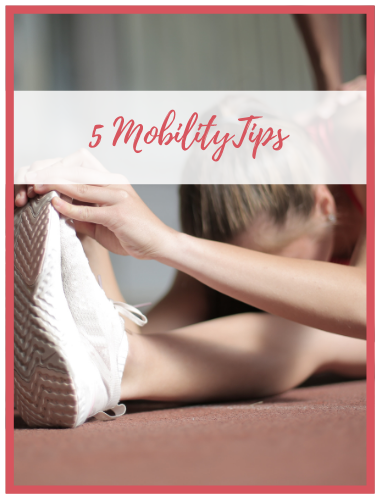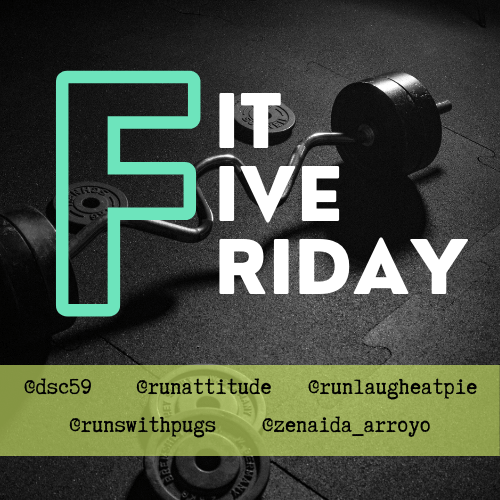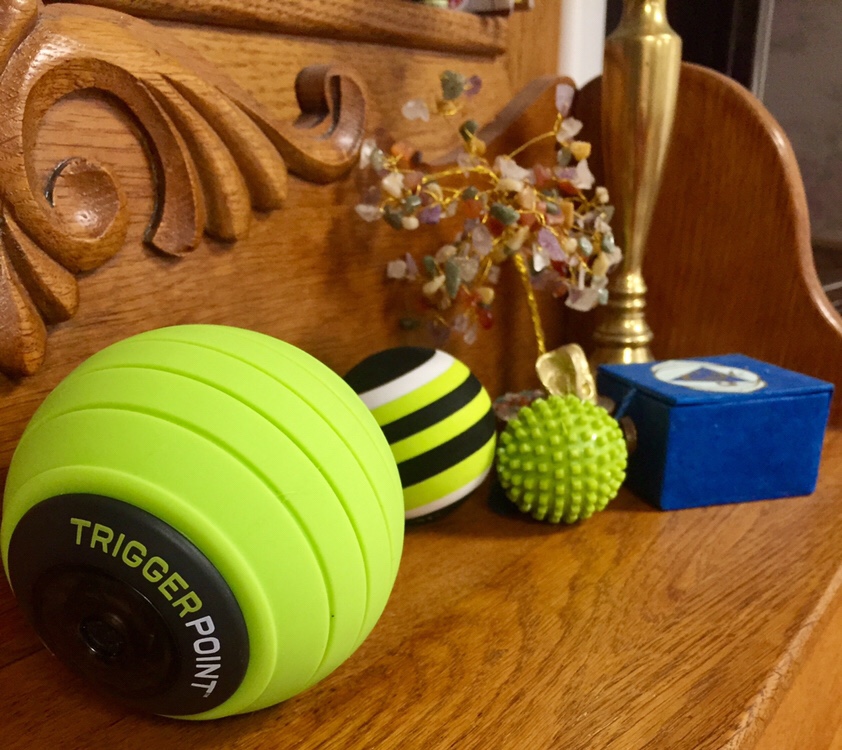
Mobility is a huge topic, and this post isn’t even an introductory post. I just wanted to share some of my takeaways from the most recent mobility course I took (you’ll fine my #1 takeaway at this post here). I hope you find something useful here!

I’m linking up with My First 5K and More, Running With Attitude, Runs with Pugs, Zenaida and Run Laugh Eat Pie for Fit Five Friday. Today I am sharing a more about mobility — something every runner can use!
1: Roll fast before running
Rolling fast helps prep the body for movement. This is something I used to do in when I first started to foam roll, then I learned that you needed to roll slow and for a longer period of time — or so I thought.
Before a run, roll fast and for a short amount of time. If you have a vibrating roller/ball, now is the time to have it on medium or high (depending on what you can tolerate).
2: Roll slow for recovery
Rolling slow does have its place: after your run. This will help you kick start the recovery response.
If you have a vibrating roller/ball, now is the time to have it on low.

3: The smaller the tool, the deeper it goes
A wider tool (think foam roller) will not give you as much pressure as a narrower tool (a ball). If you’re new to foam rolling, start with a roller, for sure. Even that may be too much if you’re not used to it.
If you’re feeling a lot of pain, back off. You should feel some sensation, but not pain.
As you get used to myofascial release techniques, you may want to consider moving from a foam roller to a ball — although start with a larger one; maybe even a softer one. Your body will adapt to whatever you use eventually, but if it really feels painful to you, not only are you not helping yourself — you’re unlikely to be consistent.
You may try moving from a larger ball to smaller and smaller balls as you get used to the pressure.
4: Add in some Functional Mobility
Often when we feel pain somewhere, it’s because the opposite muscle is weak. Adding in some functional mobility during foam rolling can really help.
Tight calves? Foam roll the calves, stop at one point, and point and flex your foot. You can also try moving it from side to side. Notice what muscles you feel that movement in.
Rolling the quads? Stop, and bend and extend the leg you’re rolling.
5: Foam Rolling can actually help our proprieception
First, what is proprieception? The dictionary says proprieception is:
perception or awareness of the position and movement of the body
As a runner, I’m sure you can see why this might be important. I can tell you from a Yoga teacher standpoint, we often get into a posture and think our leg is way higher than it actually is, or straighter than it actually is. Try videoing or photographing yourself and you might be really surprised at what you see!
I was definitely surprised to see improved proprieception as one of the benefits of foam rolling!
Final Thoughts
Although I’d like to call myself an expert on mobility, I am not. I have learned quite a bit about it in the last few months, though, and I practice what I preach. I experiment, and if it helps me, I share it.
We are all an experiment of one. So give some of these things a try, if they pique your interest, and I hope that you find it helpful.
Did you learn something new about foam rolling?
Are you willing to try to change up what you’re already doing?
What do you do to work on your mobility?

I like to foam roll before I run (when I have time)! It definitely makes sense to go faster/shorter before a run just to warm up the muscles and slow down after a run for recovery. I learned about holding a spot and moving into it a few years ago and I find that to be really helpful.
LikeLiked by 1 person
I found doing it before a run makes it much more likely to happen. 🤣
LikeLike
I’ve learned to do whatever works. It’s different for everyone.
See a professional. I used to hesitate. Now I don’t. You get relief faster than trying to fix things yourself. I love my chiro and PT.
LikeLiked by 1 person
Seeing a professional when needed is important. Practicing prehab soi don’t need to see a professional for an injury saves me a lot of $$. It’s not covered by my insurance. So prehab is my insurance.
Sometimes it’s still necessary to see a professional.
LikeLike
For me it’s only a $20 co-pay. My hubby complained about tennis elbow and sore calf for months. A few ART sessions and he was cured. And a Dr really knows what is wrong and what caused the pain.
LikeLiked by 1 person
You are lucky.
LikeLike
I have been working on hip and glute mobility and it sure does help my running. I like to do the fast roll before a run and then the longer roll for recovery as you mention. It just feels good too!
LikeLiked by 1 person
It’s funny, I used to do the fast roll before, then I changed & now I’ve changed back.
Everything old is new again. 😊
LikeLike
Often times, I’m in a hurry to get out the door (I know I’m not alone LOL). I do myt stairs and a few dynamic stretches, but I have also grabbed my beaded rolling stick and done a few swipes on my quads and glutes/hammies. Hmmm…I probably need to do a few more “swipes,” but I guess that fast motion was benefiting me more than I realized 😉
LikeLiked by 1 person
Sounds like have a great warmup routine, Kim!
LikeLike
this is a super helpful post!! I especially did not to know to roll fast before running!
LikeLiked by 1 person
Apparently rolling is an evolving science. 😊 Seriously the fast roll takes so much less time & so far so good. It’s actually how I started out. So weird. I’m sure they’ll discover something new in a few years!
LikeLike
I did not know that it is better to roll fast before a run. And better yet, I’ll put the vibrating ball to use. Thanks Judy!
LikeLiked by 1 person
I really love my vibrating ball!
LikeLike
i actually haven’t been foam rolling lately. What I learned from the Somatic Movement therapy is that foam rolling, massage, and stretching are all very temporary fixes but they don’t re-set the nervous system, which is really what’s making your muscles tight. I do some mobility exercises before running (especially for my calves and feet.) And I like your foot compressions! Who knows… i might get back to foam rolling at some point too.
LikeLiked by 2 people
Yes, I believe what you’ve learned is correct, although I do think post tun foam rolling has its place. And the fast foam rolling pre run is basically part of a warm up. So many options!
LikeLike
I have a few foam rollers but rarely use them. I prefer my massage gun. Not the same but it does help. What I really need is to get a massage!
LikeLiked by 1 person
I need a massage too!
LikeLiked by 1 person
Wow! I never knew that Judy – roll fast and short before running, slow after running. Thanks for the info. My son got one of those vibrating guns. He is having issues with his calf/Achilles and it works great for him. I want to try it.
LikeLiked by 1 person
I didn’t realize about the different speeds while rolling. That makes a lot of sense.
Yes about the smaller the tool. And boy, oh, boy, those can HURT.
LikeLiked by 1 person
🤣 yup, you gotta work from wide to smaller.
LikeLike